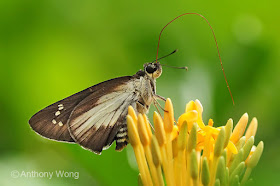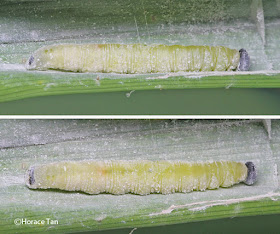Butterfly Biodata:
Genus: Unkana Distant, 1886
Species: ambasa Moore, 1858
Sub-species: batara Distant, 1886
Wingspan of Adult Butterfly: 50-65mm
Caterpillar Local Host Plants: Pandanus amarylifolius (Pandanaceae, common name: Pandan), Pandanus tectoris (Pandanaceae, common name: Seashore Pandan, Screw Pipe)
A female Hoary Palmer.
A male sighted in early morning in a western wasteland.

The upperside of a newly eclosed male, showing the yellowish spots on the forewing.
Physical Description of Adult Butterfly:
Adults are rather large in size. The females are typically larger than the males. Above, both sexes are dark brown with hyaline spots on the forewing: a large spot in the cell, four post-discal spots in spaces 2-5 in decreasing size and three small sub-apical spots in spaces 6-8. These spots are white in the female but pale yellow in the male. The female has a large white patch covering the basal two-thirds of the hindwing. Underneath, the wings are dark brown with a slight purple wash in the female but a much stronger wash in the male (for pristine specimens). The whole hindwing is strongly whitened between the veins except for the tornal area. In contrast, the forewing is only partially whitened. The adult has a rather long proboscis which is red in colour.
The upperside of a newly eclosed female, revealing the whitish spots on the forewing.
A female on a leaf perch in the late afternoon sun in a wetland reserve. Note the predominantly white hindwing.
A female taking nectar from Ixora flowers. Note the particularly long reddish proboscis.
Field Observations of Butterfly Behaviour:
This species is moderately rare in Singapore. The adults are seldom seen, due likely to its crepuscular habit. The adults are typically observed on flowering trees or shrubs at forest edge or near mangrove habitats, taking in nectar with their long proboscises.
A male Hoary Palmer taking nectar from Syzygium flowers.
Another female enjoying nectar of Ixora flowers at a forest edge.
A male visiting Syzygium flowers.
Early Stages:
The local host plants are members of the genus Pandanus of the Pandanaceae family. One recorded plant is the Pandan (Pandanus amarylifolius), a widely cultivated plant which has its aromatic leaves commonly used in Southeastern Asian cooking. The other plant, Seashore Pandan (Pandanus tectoris) is found in coastal and mangrove areas. Its leaves have been used in making mats, baskets and even grass skirts. Besides these two plants, Hoary Palmer has also been observed to utilize at least two other Pandanus spp. in the Central Catchment reserve. The caterpillars of the Hoary Palmer feed on leaves of the host plant, and live in shelters made either by joining two opposite edges of a blade together with silk threads or by joining one edge of a cut segment to the blade.
Local Host plant #1: Pandanus amarylifolius (Pandan)
Local Host plant #2: Pandanus tectoris.
Leaf shelters of Hoary Palmer caterpillars found in the field.
The eggs are laid singly on either side of a leaf of the host plant. The hemispherical egg is in a medium brownish shade of red (when fresh). The micropylar sits atop in a darker patch. The egg is rather large with a base diameter of about 2.1mm, and a height of about 1.5mm.
An egg of the Hoary Palmer.
A mature egg with the young caterpillar already nibbled away the polar part of the egg shell.
It takes about 7 days for the egg to fully mature. The egg is in light salmon colour at this stage. The young caterpillar eats just enough of the shell to emerge, and will devour the rest of the egg shell after emergence. The newly hatched has a length of about 6mm. Its has a cylindrical body shape, very short dorso-lateral and sub-spiracular setae and a tuff of long setae at the posterior end. The body is creamy yellow with a prominent black collar on the dorsum of the prothorax. The head capsule is entirely black.
A newly hatched 1st instar caterpillar in the process of nibbling away its egg shell.
An early 1st instar caterpillar resting part way through the construction of its first leaf shelter.
The body color changes to
pale yellowish green after a few feeding sessions on the leaf. The newly
hatched constructs its leaf shelter soon after it is done with the egg shell. Between feedings on the nearby leaf lamina, the caterpillar retreats to its shelter for
rest and security.
Two views of a 1st instar caterpillar, late in this stage,length: 10mm.
One noteworthy observation is
that the caterpillars of Hoary Palmer, unlike most other skipper species
which eject their frass pellets far away from their shelter, have
rather poor "toilet" discipline and do not seem to mind having frass
pellets piling up in their shelter. By the time the caterpillar lies
dormant in its
shelter for the moult to the 2nd instar, its length has reached about
11mm. The 1st instar takes about 3.5 days to complete.
A 1st instar caterpillar resting it its leaf shelter between feeds. Note the collection of frass pellets in its shelter.
A 1st instar caterpillar in a dormant state prior to its moult, length: 10.5mm.
The 2nd instar caterpillar is pale yellow with a strong green undertone. A large black patch fully cover the anal plate. The head capsule varies from black to a dark shade of reddish brown. The black collar is no longer present on the prothorax. This instar lasts about 5-6 days with the body length reaching about 16-17mm.
Two views of a 2nd instar caterpillar, length: 11.5mm.
A 2nd instar caterpillar in a dormant state prior to its moult, length: 15.5mm.
The 3nd instar caterpillar
resembles the 2nd instar caterpillar closely. One slight difference is on the anal plate where the black patch is somewhat smaller. This instar lasts about 5-6 days with the body length
reaching 23-24mm.
Two views of a 3rd instar caterpillar, length: 18mm.
A 3nd instar caterpillar in a dormant state prior to its moult, length: 23mm.
The 4th instar caterpillar again resembles the 3rd instar caterpillar closely. The black patch on the anal plate is slightly more constricted on its two sides. The head capsule is very dark reddish brown to black. This penultimate instar lasts 6-7 days with the body length reaching up to 37-38mm.
Two views of a 4th instar caterpillar, length: 27mm.
A 4th instar caterpillar in a dormant state prior to the moult, length: 37mm.
The 5th (and final) instar caterpillar has one distinct difference from the earlier instars in the black patch on the anal plate: The patch is now much smaller within the plate and has a bi-lobed shape. This instar takes about 10-12 days to complete with the body length reaching up to 55-60mm.
Two views of a 5th instar caterpillar, early in this stage, length: 39mm.
Two views of a 5th instar caterpillar, late in this instar, length: 55mm.
The head (left) and anal plate (right) of a 5th instar caterpillar.
Towards the end of the 5th instar, the body of the caterpillar shortens and its color changes to yellow with a slight green wash. As it enters the pre-pupal phase within the leaf shelter, the caterpillar excretes copious amount of white substance which can be found coating its body and lining the inner wall of the shelter. It laboriously seals both ends of the shelter with silk bands and layers of silk shields. The floor of the shelter is also covered with a mat of silk threads. Finally the pre-pupa secures itself by a silk girdle around mid-body. As the pre-pupa purges its "stomach" content before it enters this dormant state, an egg-shaped fluid sac formed from the expelled fluid can be found lying next to the pre-pupa. The sac is eventually broken by further purging action of other solid substance from the "stomach".
Two views of a pre-pupa of the Hoary Palmer.
An egg-shaped fluid sac in the pupation shelter.
The maize yellow pupa secures itself to the substrate with a cremastral attachment to the silk pad and the previously constructed silk girdle. It has a long abdomen and two small reddish lateral markings on the prothorax. The sheath containing the developing proboscis is rather long and extends well beyond the posterior end of the abdomen. Length of pupae: 30-34mm.
Two views of a pupa of the Hoary Palmer.
On the last day of the pupal period, the pupa becomes mostly black. Yellowish/whitish spots against a black background are now visible in the wing cases. The sheath holding the proboscis is now reddish, reflecting the colour of its content. Finally, after about 12-13 days of pupal phase, eclosion takes place with the adult emerging from the pupal case.
Two views of a mature pupa of the Hoary Palmer.
A newly eclosed female Hoary Palmer.
References:
- [C&P4] The Butterflies of The Malay Peninsula, A.S. Corbet and H.M. Pendlebury, 4th Edition, Malayan Nature Society.
- Butterflies of Thailand, Pisuth Ek-Amnuay, 1st Edition, 2006

































How to distinguise male and female?
ReplyDeletePlease refer to the blog article for description of the differences and pictures illustrating the differences between the two sexes of Hoary Palmer.
ReplyDelete